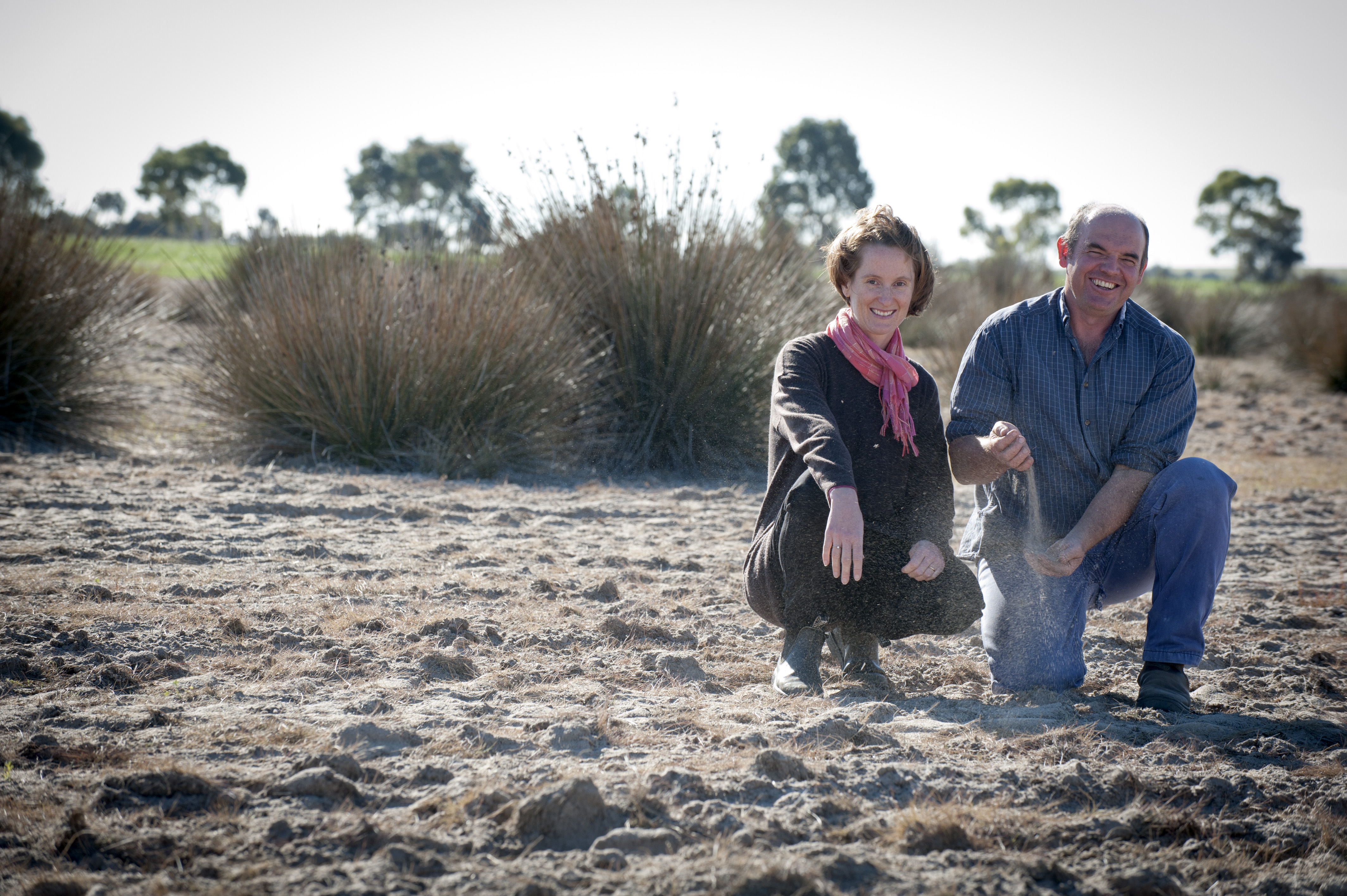
More funding has been released to help Wheatbelt farmers manage trouble spots on their properties including areas prone to wind erosion and water logging.
Natural resource management group Wheatbelt NRM has released more than $100,000 through the final round of its Soil Conservation Incentive Program.
This latest funding will go to 22 farmers who will plant a combined total of 170,000 seedlings along with 1000 kilograms of pasture seed.
One of the successful applicants was Christie and Anthony Kingston from Goomalling.
The couple has chosen to rehabilitate a 12-hectare site of non-wetting, white sand that has sub-surface summer moisture moving through the soil profile from surrounding hills.
“What we’ve been doing in the past hasn’t matched the long-term ability of this white sandy soil, so it has become increasingly non-wetting and prone to erosion,” Anthony Kingston said.
The couple has already planted tall wheatgrass at 10 kilograms to the hectare and salt tolerant Lucerne at four kilograms to the hectare on the site.
“The mix of perennials, shrubs and trees the grant provided, combined with mineral fertilisers and microbes we put out at seeding, will help towards our aim of 100 per cent cover 100 per cent of the time on this site,” Christie Kingston said.
“We hope that this green cover, combined with short bouts of grazing livestock, and then ample rest, will create the right conditions for microbial activity to bring the soil back to life.”
The grant will also allow for saltbush to be planted every two metres and swamp sheoaks every five metres to act as a border and windbreak.
“From then on, it’ll be a small but productive and low-cost part of our Merino sheep enterprise,” Anthony Kingston said.
The Kingston family run 2000 Merinos but would like to expand their livestock operations.
“If this site is successful, it’s something we plan to replicate on other similar sites but with a more diverse range of species,” he said.
This final round of Wheatbelt NRM’s Soil Conservation Incentive Program marks the end of its four-year life, funded through the Australian government’s Caring for our Country scheme.
Wheatbelt NRM’s manager for sustainable agriculture Dr Guy Boggs said over this time more than 120 farmers had benefitted.
“We’ve helped to fund more than 150 projects ranging from claying trials to growing sandalwood in the region,” Dr Guy Boggs said.
“The amount of funding that went out to landholders has been about $4 million, but that doesn’t reflect the amount of time and investment farmers have contributed themselves.
“What we’ve noticed was the number of farmers applying for grants to help improve parts of their land has been growing.
“The most popular species being planted from this round of funding was by far salt bush species, an indication of how people are recognising the value of these plants on often previously unproductive land.”
More funding has been released to help Wheatbelt farmers manage trouble spots on their properties including areas prone to wind erosion and water logging. Natural resource management group Wheatbelt NRM has released more than $100,000 through the final round of its Soil Conservation Incentive Program. This latest funding will go to 22 farmers who will plant a combined total of 170,000 seedlings along with 1000 kilograms of pasture seed. One of the successful applicants was Christie and Anthony Kingston from Goomalling. The couple has chosen to rehabilitate a 12-hectare site of non-wetting, white sand that has sub-surface summer moisture moving through the soil profile from surrounding hills. “What we’ve been doing in the past hasn’t matched the long-term ability of this white sandy soil, so it has become increasingly non-wetting and prone to erosion,” Anthony Kingston said. The couple has already planted tall wheatgrass at 10 kilograms to the hectare and salt tolerant Lucerne at four kilograms to the hectare on the site. “The mix of perennials, shrubs and trees the grant provided, combined with mineral fertilisers and microbes we put out at seeding, will help towards our aim of 100 per cent cover 100 per cent of the time on this site,” Christie Kingston said. “We hope that this green cover, combined with short bouts of grazing livestock, and then ample rest, will create the right conditions for microbial activity to bring the soil back to life.” The grant will also allow for saltbush to be planted every two metres and swamp sheoaks every five metres to act as a border and windbreak. “From then on, it’ll be a small but productive and low-cost part of our Merino sheep enterprise,” Anthony Kingston said. The Kingston family run 2000 Merinos but would like to expand their livestock operations. “If this site is successful, it’s something we plan to replicate on other similar sites but with a more diverse range of species,” he said. This final round of Wheatbelt NRM’s Soil Conservation Incentive Program marks the end of its four-year life, funded through the Australian government’s Caring for our Country scheme. Wheatbelt NRM’s manager for sustainable agriculture Dr Guy Boggs said over this time more than 130 farming enterprises had benefitted. “We’ve helped to fund more than 150 projects ranging from claying trials to growing sandalwood in the region,” Dr Guy Boggs said. “The amount of funding that went out to landholders has been about $4 million, but that doesn’t reflect the amount of time and investment farmers have contributed themselves. “What we’ve noticed is that the interest from farmers has grown with every phase of the program, with this round being heavily oversubscribed. “The most popular species being planted from this round of funding was by far salt bush species, with people keen to explore how to combine these with different pasture varieties to increase the health and value of previously unproductive land.”

